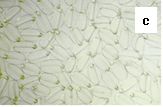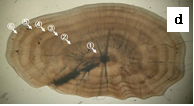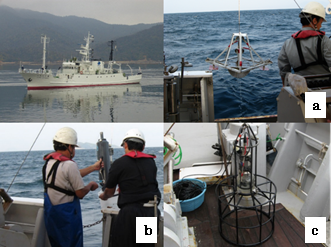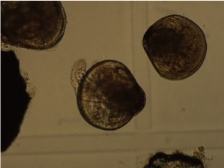Organization

Director-General
Project Management Division
●Planning and Coordination Section
The section coordinates research projects, exchanges information with related institutes and researchers, collects and disseminates information, manages public relations, and administers network communications and the library.
・Planning Subsection
・Information Subsection
●Management Section
The section manages personnel services and affairs, welfare programs, procurement, budget, and facilities.
・Administration Subsection
・Purchasing Subsection
Coastal Fisheries and Environment Division
●Coastal Fisheries Group
This group studies fisheries management and the ecology of important fisheries resources in the Seto Inland Sea, such as Japanese Spanish mackerel, Japanese anchovy, or Red seabream, to support their sustainable utilization.
 |
 |
Fig.1 Survey of fish eggs and larvae (a), sampled Japanese anchovy (b) and their eggs (c), otolith of a dagger-tooth pike conger (Muraenesox cinereus) for growth analysis (d) |
 |
 |
●Coastal Ecosystem Group
This group conducts research towards understanding and conservation of marine environments that support fisheries production of the Seto Inland Sea. The research covers a range of topics, from water quality to production at low trophic levels.
Fig.2 Marine environmental research with the research vessel “Shirafuji Maru”: seabed mud sampling (a), water sampling (b), and water quality profiler (c)
●Macrophyte and Tidal Habitat Group
This group conducts research on productivity, and ecological functions and conservation of seaweed/seagrass beds and tidal flats, for a sustainable utilization of coastal fishery resources.
Fig.3 Survey of Manila clam and other marine organisms in a tidal flat (left),
Underwater survey of a seaweed bed (right)
Research Center for Environmental Conservation
●Harmful Algal Blooms Group
This group focuses on the mechanisms, prediction, and control and mitigation of harmful algal blooms to prevent damage to fisheries and to conserve coastal environments. Another focus is on the outbreaks of paralytic and diarrhetic shellfish poisoning.
Fig.4 Harmful dinoflagellates, Karenia mikimotoi (left) is a causative organism of red tides and fish kills, Gymnodinium catenatum (right) is a causative organism of paralytic shellfish poisoning.
●Environmental Chemistry and Ecotoxicology Group
Chemical substances such as pesticides, polycyclic aromatic hydrocarbons, and antifouling biocides for ship hulls and fishing nets frequently pose a risk to organisms that inhabit the area. To keep the ecosystem in the coastal area healthy, this group conducts ecological risk assessment for these chemicals and also develops environmental remediation techniques.
Fig.5 Marine organisms used in toxicity tests (A). A snapshot of seawater sampling using the research vessel “Shirafuji maru” (B). Liquid chromatography mass spectrometry used in chemical analyses (C).
Stock Enhancement and Aquaculture Division
●Stock Enhancement Group
This group conducts research on the Tiger puffer (Takifugu rubripes) around its nursery ground in the central Seto Inland Sea, using mark and recapture experiments. The group also investigates the contribution of the stock enhancement of red-spotted grouper (Epinephelus akaara) and devil stinger (Inimicus japonicus) to natural stocks.
Fig.6 Redspotted grouper (left), Tiger puffer (right)
●Closed Recirculating Aquaculture System Group
This group develops technology for aquaculture of important fisheries species in the Seto Inland Sea, including the closed recirculating system, which is advantageous for preventing environmental pollution and fish diseases. The group also studies seed production and aquaculture technologies, using the system with a vision to establish new aquaculture industries in local areas.
Fig.7 Experimental facility of closed recirculating aquaculture system
Research Center for Marine Invertebrates
●Shellfish Group
The Shellfish group promotes studies on bivalves such as the Manila clam, examining their physiology, ecology of growth and reproduction, efficient methods for producing high quality juveniles, and the utilization of juveniles for aquaculture.
Fig.8 Manila clam adults and juveniles
●Crustacea Group
The Crustacea group promotes studies on prawns and crabs, such as the kuruma prawn, focusing on 1) physiology and nutrition related to reproduction, 2) the regulation of maturation and spawning in captivity, and 3) techniques for artificial crossbreeding.
Fig.9 Kuruma prawn
Research Vessel "Shirafuji Maru"
The “Shirafuji Maru,” built in 1983, is used for research on fisheries resources, environment, and oceanography, mainly in the Seto Inland Sea and the coast of Kyushu Island, Japan.
Fig.10 Shirafuji Maru. The Principal Particulars of this vessel are as follows:
Length : 36.50 m
Gross tonnage : 138 ton
Speed : 11.00 knot
Maximum crew : 22.
Research Vessel "Kotaka Maru"
The “Kotaka Maru,” built in 1995, has belonged to FEIS since August 2014, after a 3 year dispatch to Fukushima prefecture for the support activities after the Great East Japan Earthquake and the Tsunami in 2011. The vessel is used for research on fisheries resources, environment, and oceanography, mainly in the Seto Inland Sea.
Fig.11 Kotaka Maru. The Principal Particulars of this vessel are as follows:
Length : 30.02 m
Gross tonnage : 59 ton
Speed : 12.00 knot
Maximum crew : 10.














